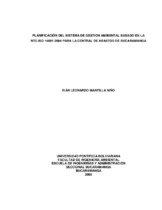| dc.contributor.advisor | Mantilla, Ivan | |
| dc.contributor.author | Mantilla Niño, Ivan Leonardo | |
| dc.coverage.spatial | Seccional Bucaramanga. Universidad Pontificia Bolivariana. Escuela de Ingeniería. Facultad de Ingeniería Ambiental | spa |
| dc.coverage.temporal | 2008 | |
| dc.date.accessioned | 2013-06-21T19:23:18Z | |
| dc.date.available | 2013-06-21T19:23:18Z | |
| dc.date.created | 2008-04-16 | |
| dc.date.issued | 2013-06-21 | |
| dc.identifier.uri | http://hdl.handle.net/20.500.11912/192 | |
| dc.description | 182p.:(pdf); il; gráficas; tablas; anexos | spa |
| dc.description.abstract | El presente trabajo hace referencia a la Planificación del Sistema de Gestión Ambiental para la Central de Abastos de Bucaramanga, en la cual diariamente se realizan actividades de comercio de frutas, verduras, pescado e insumos agropecuarios, generando aproximadamente 10 toneladas de residuos sólidos diarias, compuestas en un 90% de compuestos orgánicos. Además de ello, todas estas actividades generan aguas residuales por actividades relacionadas con baños, cafeterías, y comercio, produciendo un caudal considerado el cual va dirigido después de ser tratado por cada uno de las plantas de tratamiento al rio de Oro. Para la planificación de este sistema se utilizó una metodología específica donde se utilizaron matrices cualitativas, y una matriz cuantitativa, llamada matriz de Leopold, dando valores de magnitud e importancia. Seguidamente se identificó la normatividad aplicable de la empresa, estipulando cuales eran los decretos que se estaban cumpliendo, y clasificando el marco legal dependiendo del medio de afectación. Todo lo anterior es base para llevar a cabo la realización de la Política Ambiental de la empresa, en la cual se adquiere un compromiso de minimización de los impactos significativos. Parte fundamental es la realización de los programas, los cuales se relacionan con los impactos de significancia alta, en los cuales se estipulan objetivos y metas, preferiblemente medidos con un porcentaje, también se deben estipular medios financieros, y tecnológicos, un responsable del cumplimiento de los programas, los indicadores, y el valor para llevar a cabo su seguimiento. Finalmente, se puede concluir que el medio en el cual se produce más impacto es el agua, debido a todos los vertimientos que se producen por las diferentes actividades de comercio, de tal forma que se debe analizar la efectividad de las tres plantas de tratamiento, con el fin de dar cumplimiento al decreto 1594 / 84, referente a los usos del agua y residuos líquidos. | spa |
| dc.description.abstract | This work makes a reference to the Bucaramanga’s Centro Abastos’ Environmental Management System Planification, in which daily a big quantity of fruit, vegetables, fish and appertaining to land and cattle supplies are traded, generating approximately 10 tons of organic solid leavings daily, composed in a 90% of organic compounds.
Besides of this fact, all those activities generate residual water due to activities related to bathrooms, cafeterias, and trading, producing a considerable caudal which is addressed to the Oro River after being processed in each treatment plant.
In the Planification of this system a specific methodology was used, where qualitative matrixes and a quantity matrix, called Leopold’s matrix was used, giving values of magnitude and importance.
After that, next step was to identify the applicable set of norms to the company, stipulating which decrees where being taking into account, and classifying the legal frame depending on the affectation environment.
A fundamental part is the realization of the programs, taking consequence with the high meaning impacts, in which the main objectives and goals are stipulated, preferably measured with a percentage. Also the financial and technologic means must be stipulated, as well as a responsible of the program’s compliment, the indicators, and the final cost to carry out the project.
Finally, it can be concluded that the environment in which the highest impact is produced is water, due to all the spilling produced by the different trading activities, of such form that the effectiveness of the treatment plants must be analyzed, with the concern to give compliment to de 1594/84 decrees related to the water’ uses and liquid leavings. | |
| dc.language.iso | es | |
| dc.rights | Attribution-NonCommercial-NoDerivatives 4.0 International | * |
| dc.rights.uri | http://creativecommons.org/licenses/by-nc-nd/4.0/ | * |
| dc.subject | Trabajos de ingeniería ambiental | spa |
| dc.subject | Tesis y disertaciones académicas | spa |
| dc.subject | Ingeniería ambiental | spa |
| dc.subject | Abastecimiento de alimentos | spa |
| dc.subject | Gestión ambiental | spa |
| dc.subject | Normas técnicas - ISO 14001 | spa |
| dc.subject | Central de abasto de Bucaramanga S.A - Centroabastos | spa |
| dc.title | Planificación del sistema de gestión ambiental basado en la NTC-ISO 14001 para la central de abastos de Bucaramanga. | spa |
| dc.type | bacherlorThesis | spa |
| dc.rights.accessRights | openAccess | spa |
| dc.type.hasVersion | publishedVersion | spa |
| dc.identifier.instname | instname:Universidad Pontificia Bolivariana | spa |
| dc.identifier.reponame | reponame:Repositorio Institucional de la Universidad Pontificia Bolivariana | spa |
| dc.identifier.repourl | repourl:https://repository.unab.edu.co/ | |


